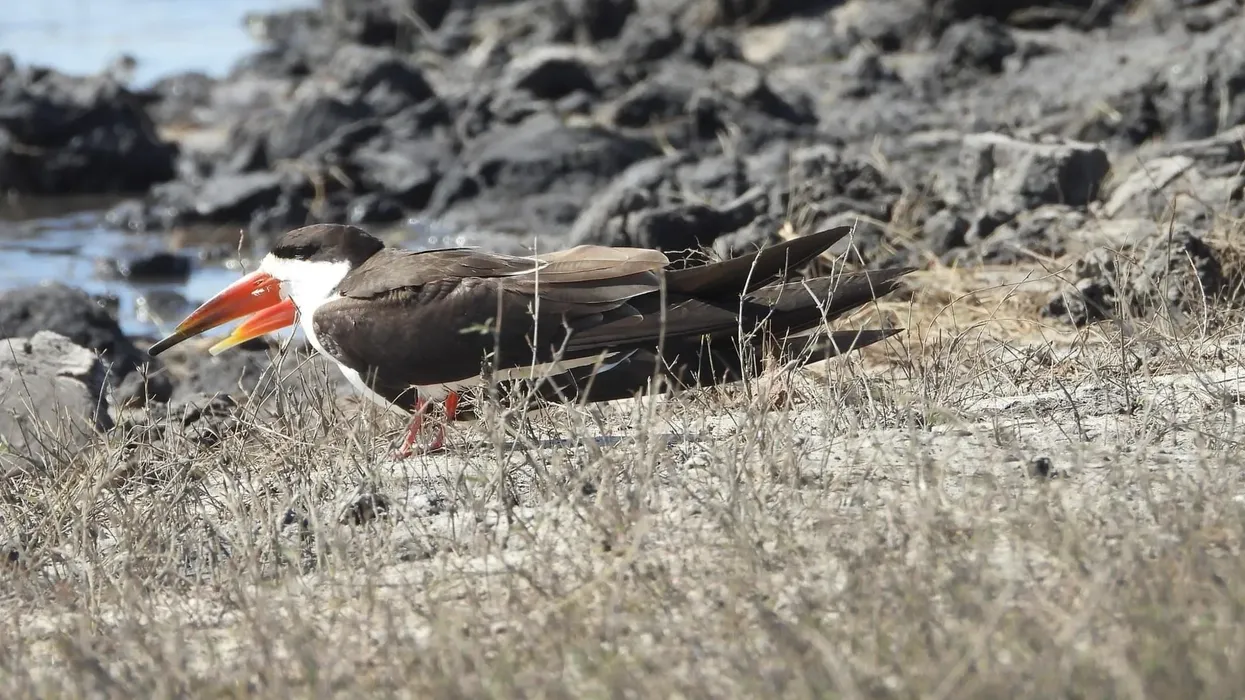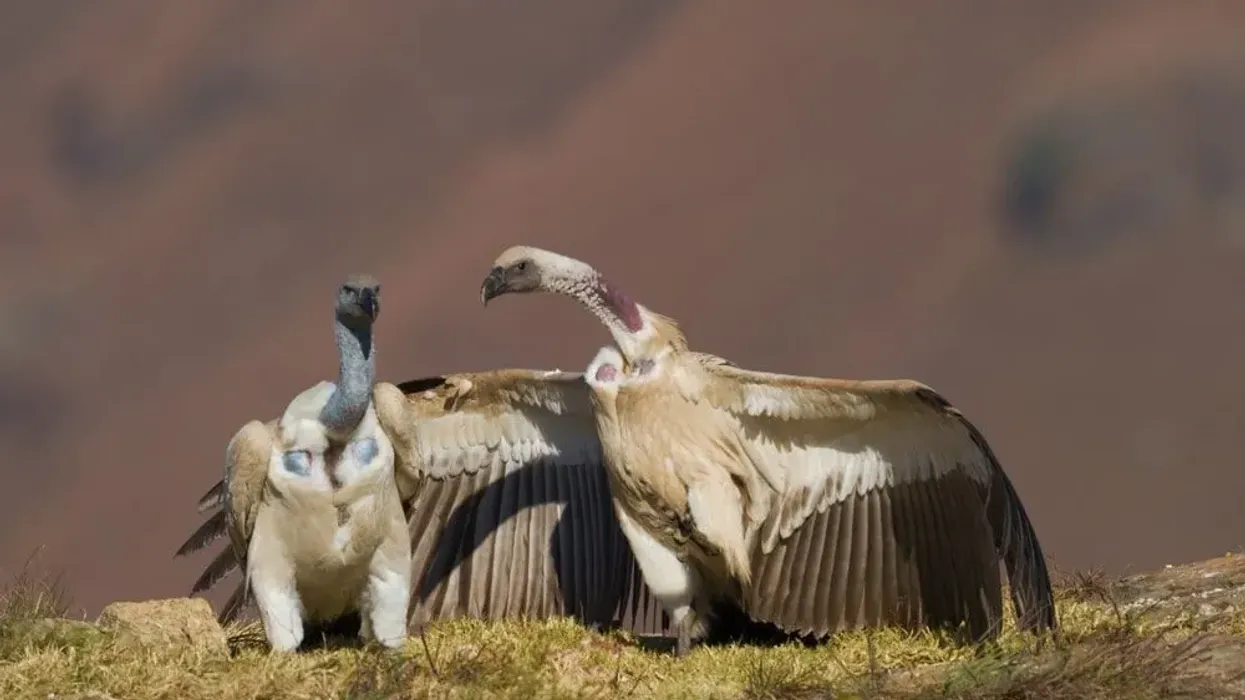The African skimmer (Rynchops flavirostris) can be seen flying in synchronized unison with their long wings, gliding next to the Congo River and also flying across the Nile valley and many other regions throughout South Africa.
African skimmers are sea birds and happen to be one of the three types of species of the genus Rynchops.
Their family has two more bird species, the black skimmer (Rynchops niger) which is strictly found in the coastal regions of North America and the Indian skimmer (Rynchops albicollis) which can be found in the coastal estuaries towards north west and north east India.
The African skimmer eyeball happens to be quite large in size and these birds are also known for their blade-like bill called mandibles.
The lower mandible is significantly longer than the upper mandible, and these birds can be seen using their lower mandible in order to scoop out little fishes from the ocean or rivers just like the character Nigel, the brown pelican from 'Finding Nemo'!
To know more about similar birds that can be found in North America, check out these amazing facts about the American Oystercatcher and little blue heron.
African Skimmer Interesting Facts
What type of animal is an African skimmer?
The African skimmer (Rynchops flavirostris) bird belongs to the family Laridae and are big terns, meaning they are sea birds. These birds are well known for their skimming habits, their unique bill, and their exceptional fish hunting skills using their lower mandible and their upper mandible.
What class of animal does an African skimmer belong to?
Like most other species of birds found in the wild, this black and white bird belongs to the animal class of Aves.
How many African skimmers are there in the world?
This endangered species has an estimated population of around 8,000-12,000 birds throughout eastern and southern African regions. Some other skimmers such as the black skimmer can be found in parts of North America.
Where do African skimmers live?
African skimmers can be seen making their nest in many parts of Africa which happens to be the primary location of distribution for these birds. Their distinct calls can be heard in many places along the coastal regions of Sub-Saharan Africa. Some of these birds may also be found near islands in northern and southern Africa.
What is an African skimmer's habitat?
The African black skimmer bird usually prefers to live alongside wetlands, rivers, lakes, lagoons, or the ocean. These all happen to be the primary places of their distribution.
They can be found in small or huge flocks with around 900-1,000 birds or in a breeding range of 20-60 nests.
Their habitat includes places along tropical coastal areas or where sand can be found for making their nest and roosting while some of their nests can also be found next to big lakes. Their nests can also be found on sandy islands.
Who do African skimmers live with?
These skimmers are hostile in nature and live together in small colonies in pairs. Each pair keeps growing their territories within the breeding area and their distinct calls can be heard throughout these regions.
How long do African skimmers live?
The African skimmer (Rynchops flavirostris) may live up to 5-15 years in the wild however, a bird like the black skimmer may live much longer.
How do they reproduce?
Unlike black skimmers, African skimmers reproduce in huge flocks known as colonies. Breeding season usually takes place in the dry season when rivers and sand bars are at the lowest.
After copulation, females lay around two to three eggs in a nest along the sandy lagoon chores. The parents are then seen nesting and nursing the eggs for a few weeks. They continue nesting until the baby bird chicks become about a month old and can fly away from their nest on their own.
What is their conservation status?
Populations of this species of tern bird have been decreasing steadily over the last few years. Currently, the conservation status of this tern bird is listed as Near Endangered by the IUCN. A reason attributing to this decline is the shift in climate during the various seasons and also pollution.
African Skimmer Fun Facts
What do African skimmers look like?
These long-winged birds have black backs, hind necks, and crowns while the rest of their body color is white.
These black and white birds have a short forked tail which is white, and their legs are bright red. Unlike the black skimmer of North America, the average size of this skimmer bird is about 15 in (38 cm) in length.
The most striking feature of this species is its bill that allows them to skim through the water since the lower mandible is longer than the upper mandible and is flattened sideways which makes feeding by skimming quite easy.
Another unique feature observed in this bird is its eyes. The African skimmer eye is vertical and it has got big pupils, making them adaptable to search and hunt for food in dull areas.
They mostly rely on their sense of touch through their bills. When these birds fly low, the bill is wide open with their lower mandible in the water and when they can feel a fish trapped, they quickly close their jaws. The calls of these birds happen to be really unique as well.

How cute are they?
These birds, even though plainly white and black in color, are quite adorable especially their cute little tail. These terns are extremely cute and the chicks of this species look adorable while eating food.
How do they communicate?
They communicate by vocalizing and displaying. The skimmers sharp calls go like 'kak-kak' or 'kip-kip' sound very similar to the call which is made by the black skimmer. The calls of these birds have become quite a rare occurrence since the conservation status of this calm bird has plummeted a lot over the last few years.
How big is an African skimmer?
These birds are 16–20 in (40-50 cm) in length with a 42–50 in (107–127 cm) wingspan.
How fast can an African skimmer fly?
While foraging, these skimmers with their long wings are in a slow flight, just a little bit higher than boats and ships as they are hunting for their prey.
How much does an African skimmer weigh?
The average weight range is about 10.3 oz (28.9 g) whereas the black skimmer species ranges from 7.5-15.8 oz (212-447 g).
What are the male and female names of the species?
The male and female species do not hold any specific title for their sexes.
What would you call a baby African skimmer?
An African skimmer baby does not have any specific name but since it belongs to the species of birds, it is called a chick.
What do they eat?
Their diet usually consists of small fish that they can go skimming for quite easily. While in flight for foraging, these birds are quite focused and do not get distracted. Some of the different fish they eat include round goby, ladyfish, red mullet, and killifish. They also eat squid, shrimp, insects, crabs, and other small marine creatures.
Are they poisonous?
These birds are not poisonous but they are slightly aggressive in nature so they might peck you if you are too close to them.
Would they make a good pet?
No, these birds would not make a good pet because it is not legal to own this species as a pet and these are seabirds who prefer to live by the ocean side.
They also feed on fishes and other marine creatures so chances are that if you own a fish tank, you probably would notice the disappearance of your other fish.
Did you know...
The bird's genus name Rhynchops comes from a Greek word which also means 'bill' and 'face' which are to do with their distinctive lower mandible and upper mandible, They also have nicknames like scissor bill, seadog, and razorbill.
African skimmers (Rhynchops niger) are usually seen in flocks and can be easily seen by predators but due to the heavy population of this species in groups, it is also easier for them to spot the predator and take flight.
As this is an endangered species, they cannot be freely found in the wildlife. Therefore, at present, they are kept safe in the zoo where their diet consists of small fish, krill, and other types of seafood.
They cannot swim, even though these birds spend most of their lives around rivers, lakes, and the ocean.
What's the difference between the African skimmer and the Indian skimmer?
The main difference between the African skimmer and the Indian skimmer is that the Indian tern bird happens to look different in terms of color. A non-breeding adult is dull gray or brownish color with pale fringes on the feathers.
Like the African and black skimmer, the Indian skimmer family is usually quite silent. The Indian skimmer family is mostly found in sandy areas, near rivers, and estuaries. Nonetheless, the black skimmer is the largest among these species.
Are African skimmers endangered?
The conservation status of this bird happens to be listed as Near Endangered by the IUCN mainly because of the lack of nesting, loss of habitat, climate changes, and pollution. However, you can still find a large chunk of the black skimmer population thriving in America.
Here at Kidadl, we have carefully created lots of interesting family-friendly animal facts for everyone to discover! Learn more about some other birds from our Australian pelican facts and green heron facts pages.
You can even occupy yourself at home by coloring in one of our free printable Japanese night heron coloring pages.










